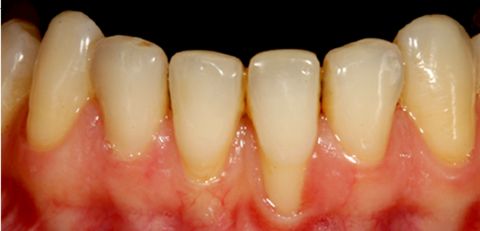The procedure involves removing excess gum and bone and then appropriately shaping the gum line. To visually expose more of the tooth. This procedure is performed on one or several teeth. Sometimes correcting a gummy smile involves the need to make veneers or crowns. By restoring harmony between the gums and teeth, the patient smiles more confidently and more often.
Treatment of gum recession
at Niewada Clinic

Modern dentistry means functioning in complete harmony, the so-called “white and red aesthetics”. Maintaining the natural proportions of teeth and gums allows the smile to fit perfectly into the frame of the mouth. Thanks to the field of periodontal microsurgery, in our clinic we correct irregular gum lines, exposed tooth necks, too long or too short crowns, or gum or bone loss after an extracted tooth.
Each case is assessed individually by us. Based on thorough diagnostics, we select the most promising treatment process, which we will discuss with you during a visit to our clinic.
What is gum recession?
Recession is the exposure of the root surface as a result of the apical shift of the gum line (“gum escape”), as a result of which the teeth become optically too long and are more sensitive to heat and cold. Moreover, they are more susceptible to caries!
Microsurgery in the treatment of recession
Microsurgery comes to the rescue. Before starting the procedure, it is important to precisely determine the cause of the recession and then eliminate it. The main causes are occlusal disorders, periodontitis and incorrect brushing.
How to stop the process?
Covering the recession allows you to recreate the lost gum and stop the process of root exposure. As a result, it prevents the loss of bone surrounding the tooth, protects it against caries, reduces hypersensitivity and improves aesthetics.




FAQ / Gum recession
What causes gum recession?
Recessions are often the result of tooth overload related to bruxism, i.e. grinding and clenching of teeth, the presence of thin and delicate gums, imprecisely made and polished “fillings” and prosthetic crowns, as well as aggressive brushing and the use of too hard toothbrushes.
What to do when the roots are exposed?
First of all, you need to eliminate the causes of recession, i.e. learn how to brush your teeth properly, replace incorrectly made fillings or crowns and eliminate tooth overload. Sometimes it is necessary to correct the incorrect position of teeth using orthodontic treatment. After eliminating the causes, you can start correcting the recession.
How to prepare for the recession coverage procedure?
Before covering the recession, you should take care of your oral hygiene, which may determine the success of the therapy. Therefore, before the procedure, you will need to visit our professional hygienist.
What should you do to speed up the gum healing process?
Gum recession is a disorder in which the gums recede and expose the root surface of the teeth. They are often an aesthetic problem and may cause hypersensitivity to heat and cold, sour or sweet foods, as well as to brushing. The exposed root is exposed to direct attack by irritating factors and bacteria, which may predispose to the development of caries or inflammation of the tooth pulp and, consequently, to root canal treatment.
See how we can help you:
Implantology/ Bonding / Root canal treatment /Orthodontics / Bioesthetic dentistry / Periodontology / Treatment of bruxism / Gum recession / Prosthetics/ Dental surgery / Smile design / Prevention and hygiene / Teeth whitening / Dental physioterapy / Anesthesia / Conservative dentistry / Smile Design / Teeth whitening


